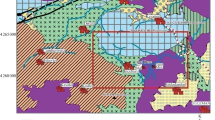Abstract
This paper presents the results of the δ18O study of the precious opals from Primor’e (Raduzhnoe deposit), Australia, and Ethiopia and the modern opals from the hydrotherms of the Mendeleev Volcano (Kunashir Island, Kuril Islands). It is established that the oxygen isotope ratio in opals may serve as a criterion for the estimation of their formation temperature. The low-temperature sedimentary opals are relatively enriched in the heavy oxygen isotope independently of the sedimentary or volcanic host rocks. Examples are the Australian and Slovakian opals of the A-type. The hydrothermal opals are enriched in the light oxygen isotope, which depends on the precipitation temperature. The higher the temperature, the lighter the oxygen isotope ratio of the precipitating opal is and the closer it is to that of the hydrothermal fluid.
Similar content being viewed by others
Referenes
S. V. Vysotskii, V. G. Kuryavyi, and A. A. Karabtsov, “Nanostructure of noble opal from the Raduzhnoe Deposit, northern Primorye, Russia,” Dokl. Earth Sci. 420(4), 690–692 (2008).
S. V. Vysotskii, A. V. Barkar, V. G. Kuryavyvi, E. A. Chusovitin, A. A. Karabtsov, and P. P. Safronov, “Hydrothermal noble opals: structure and genesis,” Zap. Ross. Mineral. O-va, No. 6, 62–70 (2009).
S. V. Vysotskii, N. G. Galkin, A. V. Barkar, E. A. Chusovitin, and A. A. Karabtsov, “Hydrothermal precious opals of the Raduzhnoe Deposit, North Primorye: the nature of the opalescence,” Russ. J. Pac. Geol. 4(4), 347–354 (2010).
N. D. Deniskina, D. V. Kalinin, and L. K. Kazantseva, Noble Opals (Nauka, Novosibirsk, 1987) [in Russian].
O. V. Chudaev, Composition and Conditions of Formation of the Hydrothermal Systems of the Russian Far East (Dal’nauka, Vladivostok, 2003) [in Russian].
H. I. Craig, “Isotopic Variations in Meteoric Waters,” Science 133, 1702–1703 (1961).
K. Dowell, J. Mavrogenes, D. C. McPhail, and J. Watkins, “Origin and timing of formation of precious opal nobbies at Lightning Ridge,” in Regolith and Landscapes in Eastern Australia, Ed. by I. C. Roah (CRC LEME, 2002), pp. 18–20.
E. Fritsch, L. Mihut, M. Baibarac, I. Baltog, M. Ostrooumov, S. Lefrant, and J. Wery, “Luminescence of oxidized porous silicon: surface-induced emissions from disordered silica microto nanotextures,” J. Appl. Physics 90(9), 4777–4782 (2001).
E. Gaillou, E. Fritsch, B. Aguilar-Reyes, B. Rondeau, J. Post, A. Barreau, and M. Ostroumov, “Common gem opal: an investigation of microto nano-structure,” Am. Mineral. 93, 1865–1873 (2008).
M. L. Jackson, R. N. Clayton, N. Fujii, and J. H. Henderson, “Cristobalite morphology and oxygen isotopic composition variation under hydrothermal alteration,” Clays Clay Miner. 25, 31–38 (1977).
M. Ostrooumov, E. Fritsch, B. Lasnier, and S. Lefrant, “Spectres Raman des opales: aspect diagnostic et aide á la classification,” J. Mineral. 11, 899–908 (1999).
B. Rondeau, E. Fritsch, M. Guiraud, and C. Renac, “Opals from Slovakia (“Hungarian” opals): a reassessment of the conditions of formation,” Eur. J. Mineral. 16, 789–799 (2004).
A. Smallwood, P. S. Thomas, and A. S. Ray, “Characterization of sedimentary opals by fourier transform raman spectroscopy,” Spectrochim. Acta A 53, 2341–2345 (1997).
A. Smallwood, “A preliminary investigation of precious opal by laser Raman spectroscopy,” Austral. Gem. 20, 363–266 (2000).
H. P. Taylor, Jr., “Oxygen and hydrogen isotope relationships in hydrothermal mineral deposits,” in Geochemistry of Hydrothermal Ore Deposits, Ed. by H. L. Barnes (Wileys, New York, 1979).
R. C. Wallace, “The mineralogy of the Tokomaru silt loam and the occurrence of cristobalite and tridymite in selected North Island soils,” New Zealand J. Geol. Geophys 34(113), (1991).
Author information
Authors and Affiliations
Corresponding author
Additional information
Original Russian Text © S.V. Vysotskiy, A.V. Ignatiev, A.G. Khlestunova, T.A. Velivetskaya, A.S. Okrugin, 2013, published in Tikhookeanskaya Geologiya, 2013, Vol. 32, No. 6, pp. 64–67.
Rights and permissions
About this article
Cite this article
Vysotskiy, S.V., Ignatiev, A.V., Khlestunova, A.G. et al. Peculiarities of the oxygen isotope ratio in precious opals. Russ. J. of Pac. Geol. 7, 427–430 (2013). https://doi.org/10.1134/S1819714013060079
Received:
Published:
Issue Date:
DOI: https://doi.org/10.1134/S1819714013060079




